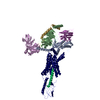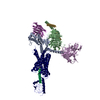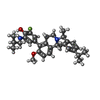[English] 日本語
 Yorodumi
Yorodumi- EMDB-24401: cryo-EM structure of human Gastric inhibitory polypeptide recepto... -
+ Open data
Open data
- Basic information
Basic information
| Entry |  | |||||||||
|---|---|---|---|---|---|---|---|---|---|---|
| Title | cryo-EM structure of human Gastric inhibitory polypeptide receptor GIPR bound to tirzepatide | |||||||||
 Map data Map data | ||||||||||
 Sample Sample |
| |||||||||
| Function / homology |  Function and homology information Function and homology informationgastric inhibitory peptide receptor activity / glucagon family peptide binding / gastric inhibitory peptide signaling pathway / endocrine pancreas development / desensitization of G protein-coupled receptor signaling pathway / response to fatty acid / G protein-coupled peptide receptor activity / peptide hormone binding / response to glucose / response to axon injury ...gastric inhibitory peptide receptor activity / glucagon family peptide binding / gastric inhibitory peptide signaling pathway / endocrine pancreas development / desensitization of G protein-coupled receptor signaling pathway / response to fatty acid / G protein-coupled peptide receptor activity / peptide hormone binding / response to glucose / response to axon injury / activation of adenylate cyclase activity / response to nutrient / regulation of insulin secretion / generation of precursor metabolites and energy / response to calcium ion / positive regulation of insulin secretion / adenylate cyclase-modulating G protein-coupled receptor signaling pathway / Olfactory Signaling Pathway / adenylate cyclase-activating G protein-coupled receptor signaling pathway / Activation of the phototransduction cascade / G beta:gamma signalling through PLC beta / Presynaptic function of Kainate receptors / Thromboxane signalling through TP receptor / G protein-coupled acetylcholine receptor signaling pathway / Activation of G protein gated Potassium channels / Inhibition of voltage gated Ca2+ channels via Gbeta/gamma subunits / G-protein activation / G beta:gamma signalling through CDC42 / Prostacyclin signalling through prostacyclin receptor / Glucagon signaling in metabolic regulation / G beta:gamma signalling through BTK / Synthesis, secretion, and inactivation of Glucagon-like Peptide-1 (GLP-1) / ADP signalling through P2Y purinoceptor 12 / photoreceptor disc membrane / Sensory perception of sweet, bitter, and umami (glutamate) taste / Glucagon-type ligand receptors / Adrenaline,noradrenaline inhibits insulin secretion / Vasopressin regulates renal water homeostasis via Aquaporins / Glucagon-like Peptide-1 (GLP1) regulates insulin secretion / G alpha (z) signalling events / transmembrane signaling receptor activity / ADP signalling through P2Y purinoceptor 1 / cellular response to catecholamine stimulus / ADORA2B mediated anti-inflammatory cytokines production / G beta:gamma signalling through PI3Kgamma / adenylate cyclase-activating dopamine receptor signaling pathway / Cooperation of PDCL (PhLP1) and TRiC/CCT in G-protein beta folding / GPER1 signaling / G-protein beta-subunit binding / cellular response to prostaglandin E stimulus / heterotrimeric G-protein complex / Inactivation, recovery and regulation of the phototransduction cascade / G alpha (12/13) signalling events / extracellular vesicle / sensory perception of taste / Thrombin signalling through proteinase activated receptors (PARs) / signaling receptor complex adaptor activity / positive regulation of cytosolic calcium ion concentration / retina development in camera-type eye / GTPase binding / Ca2+ pathway / fibroblast proliferation / High laminar flow shear stress activates signaling by PIEZO1 and PECAM1:CDH5:KDR in endothelial cells / G alpha (i) signalling events / G alpha (s) signalling events / phospholipase C-activating G protein-coupled receptor signaling pathway / G alpha (q) signalling events / Hydrolases; Acting on acid anhydrides; Acting on GTP to facilitate cellular and subcellular movement / Ras protein signal transduction / cell surface receptor signaling pathway / Extra-nuclear estrogen signaling / cell population proliferation / G protein-coupled receptor signaling pathway / lysosomal membrane / GTPase activity / synapse / protein-containing complex binding / signal transduction / extracellular exosome / membrane / plasma membrane / cytosol / cytoplasm Similarity search - Function | |||||||||
| Biological species |  Homo sapiens (human) / Homo sapiens (human) /   | |||||||||
| Method | single particle reconstruction / cryo EM / Resolution: 3.08 Å | |||||||||
 Authors Authors | Sun B / Kobilka BK / Sloop KW / Feng D / Kobilka TS | |||||||||
 Citation Citation |  Journal: Proc Natl Acad Sci U S A / Year: 2022 Journal: Proc Natl Acad Sci U S A / Year: 2022Title: Structural determinants of dual incretin receptor agonism by tirzepatide. Authors: Bingfa Sun / Francis S Willard / Dan Feng / Jorge Alsina-Fernandez / Qi Chen / Michal Vieth / Joseph D Ho / Aaron D Showalter / Cynthia Stutsman / Liyun Ding / Todd M Suter / James D Dunbar ...Authors: Bingfa Sun / Francis S Willard / Dan Feng / Jorge Alsina-Fernandez / Qi Chen / Michal Vieth / Joseph D Ho / Aaron D Showalter / Cynthia Stutsman / Liyun Ding / Todd M Suter / James D Dunbar / John W Carpenter / Faiz Ahmad Mohammed / Eitaro Aihara / Robert A Brown / Ana B Bueno / Paul J Emmerson / Julie S Moyers / Tong Sun Kobilka / Matthew P Coghlan / Brian K Kobilka / Kyle W Sloop /   Abstract: SignificanceTirzepatide is a dual agonist of the glucose-dependent insulinotropic polypeptide receptor (GIPR) and the glucagon-like peptide-1 receptor (GLP-1R), which are incretin receptors that ...SignificanceTirzepatide is a dual agonist of the glucose-dependent insulinotropic polypeptide receptor (GIPR) and the glucagon-like peptide-1 receptor (GLP-1R), which are incretin receptors that regulate carbohydrate metabolism. This investigational agent has proven superior to selective GLP-1R agonists in clinical trials in subjects with type 2 diabetes mellitus. Intriguingly, although tirzepatide closely resembles native GIP in how it activates the GIPR, it differs markedly from GLP-1 in its activation of the GLP-1R, resulting in less agonist-induced receptor desensitization. We report how cryogenic electron microscopy and molecular dynamics simulations inform the structural basis for the unique pharmacology of tirzepatide. These studies reveal the extent to which fatty acid modification, combined with amino acid sequence, determines the mode of action of a multireceptor agonist. | |||||||||
| History |
|
- Structure visualization
Structure visualization
| Supplemental images |
|---|
- Downloads & links
Downloads & links
-EMDB archive
| Map data |  emd_24401.map.gz emd_24401.map.gz | 96.5 MB |  EMDB map data format EMDB map data format | |
|---|---|---|---|---|
| Header (meta data) |  emd-24401-v30.xml emd-24401-v30.xml emd-24401.xml emd-24401.xml | 21.3 KB 21.3 KB | Display Display |  EMDB header EMDB header |
| Images |  emd_24401.png emd_24401.png | 113.1 KB | ||
| Archive directory |  http://ftp.pdbj.org/pub/emdb/structures/EMD-24401 http://ftp.pdbj.org/pub/emdb/structures/EMD-24401 ftp://ftp.pdbj.org/pub/emdb/structures/EMD-24401 ftp://ftp.pdbj.org/pub/emdb/structures/EMD-24401 | HTTPS FTP |
-Validation report
| Summary document |  emd_24401_validation.pdf.gz emd_24401_validation.pdf.gz | 507.7 KB | Display |  EMDB validaton report EMDB validaton report |
|---|---|---|---|---|
| Full document |  emd_24401_full_validation.pdf.gz emd_24401_full_validation.pdf.gz | 507.3 KB | Display | |
| Data in XML |  emd_24401_validation.xml.gz emd_24401_validation.xml.gz | 6.2 KB | Display | |
| Data in CIF |  emd_24401_validation.cif.gz emd_24401_validation.cif.gz | 7 KB | Display | |
| Arichive directory |  https://ftp.pdbj.org/pub/emdb/validation_reports/EMD-24401 https://ftp.pdbj.org/pub/emdb/validation_reports/EMD-24401 ftp://ftp.pdbj.org/pub/emdb/validation_reports/EMD-24401 ftp://ftp.pdbj.org/pub/emdb/validation_reports/EMD-24401 | HTTPS FTP |
-Related structure data
| Related structure data |  7rbtMC  7ra3C  7rg9C  7rgpC M: atomic model generated by this map C: citing same article ( |
|---|---|
| Similar structure data | Similarity search - Function & homology  F&H Search F&H Search |
- Links
Links
| EMDB pages |  EMDB (EBI/PDBe) / EMDB (EBI/PDBe) /  EMDataResource EMDataResource |
|---|---|
| Related items in Molecule of the Month |
- Map
Map
| File |  Download / File: emd_24401.map.gz / Format: CCP4 / Size: 103 MB / Type: IMAGE STORED AS FLOATING POINT NUMBER (4 BYTES) Download / File: emd_24401.map.gz / Format: CCP4 / Size: 103 MB / Type: IMAGE STORED AS FLOATING POINT NUMBER (4 BYTES) | ||||||||||||||||||||||||||||||||||||
|---|---|---|---|---|---|---|---|---|---|---|---|---|---|---|---|---|---|---|---|---|---|---|---|---|---|---|---|---|---|---|---|---|---|---|---|---|---|
| Projections & slices | Image control
Images are generated by Spider. | ||||||||||||||||||||||||||||||||||||
| Voxel size | X=Y=Z: 0.832 Å | ||||||||||||||||||||||||||||||||||||
| Density |
| ||||||||||||||||||||||||||||||||||||
| Symmetry | Space group: 1 | ||||||||||||||||||||||||||||||||||||
| Details | EMDB XML:
|
-Supplemental data
- Sample components
Sample components
+Entire : cryo-EM of human Gastric inhibitory polypeptide receptor GIPR bou...
+Supramolecule #1: cryo-EM of human Gastric inhibitory polypeptide receptor GIPR bou...
+Supramolecule #2: Tirzepatide bound to GIP receptor GIPR
+Supramolecule #3: Trimeric stimulatory G protein
+Macromolecule #1: Isoform Gnas-2 of Guanine nucleotide-binding protein G(s) subunit...
+Macromolecule #2: Guanine nucleotide-binding protein G(I)/G(S)/G(T) subunit beta-1
+Macromolecule #3: Single-chain variable fragment 16
+Macromolecule #4: Guanine nucleotide-binding protein G(I)/G(S)/G(O) subunit gamma-2
+Macromolecule #5: nanobody 35
+Macromolecule #6: Tirzepatide
+Macromolecule #7: Gastric inhibitory polypeptide receptor
+Macromolecule #8: 2-fluoro-4-[(1R)-6-methoxy-1-methyl-2-{(1S)-1-[4-(propan-2-yl)phe...
-Experimental details
-Structure determination
| Method | cryo EM |
|---|---|
 Processing Processing | single particle reconstruction |
| Aggregation state | particle |
- Sample preparation
Sample preparation
| Concentration | 10 mg/mL |
|---|---|
| Buffer | pH: 7.5 |
| Vitrification | Cryogen name: ETHANE / Chamber humidity: 100 % / Chamber temperature: 293 K / Instrument: FEI VITROBOT MARK IV |
- Electron microscopy
Electron microscopy
| Microscope | FEI TITAN KRIOS |
|---|---|
| Specialist optics | Energy filter - Name: GIF Quantum LS / Energy filter - Slit width: 20 eV |
| Image recording | Film or detector model: GATAN K3 (6k x 4k) / Detector mode: COUNTING / Average exposure time: 1.5 sec. / Average electron dose: 53.6 e/Å2 |
| Electron beam | Acceleration voltage: 300 kV / Electron source:  FIELD EMISSION GUN FIELD EMISSION GUN |
| Electron optics | Illumination mode: FLOOD BEAM / Imaging mode: BRIGHT FIELD / Cs: 2.7 mm |
| Experimental equipment |  Model: Titan Krios / Image courtesy: FEI Company |
 Movie
Movie Controller
Controller























 Z (Sec.)
Z (Sec.) Y (Row.)
Y (Row.) X (Col.)
X (Col.)

























